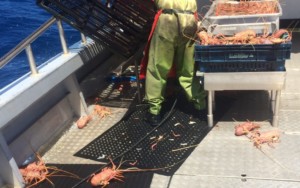Privacy Notice
This website uses cookies to improve your experience. Read our Privacy Policy to learn more.
It’s the time of year when your lobsters are subjected to conditions that take the largest toll on quality: hot weather, wind and (as a result) increased salinity can all have devastating effects on lobster quality. With big catches coming up, careful preparation and good procedures can save you a lot of money!
Hot weather and hot wind not only have direct effects on lobsters (by heating them up), increased evaporation means that all surfaces have higher concentrations of salt. Hyper-salinity causes catastrophic leg loss. Avoid problems associated with hyper-salinity by making sure deckies regularly use seawater to wash down gloves, cakka boxes and anything else that is likely to contact lobsters.
On the subject of cakka boxes, some fishermen falsely believe that a cakka box is big enough if it only gets overfull on ‘big days’ But these are the days when quality is most likely to suffer – for all the reasons above. The picture below shows a cakka box that is way too small – many lobsters are exposed to hot dry winds. As for the ones that have fallen on the deck, look at the leg loss!

This cakka box is too small! Consider upsizing your cakka box if lobsters are falling on the deck

Deckies should be told to return lobsters that have fallen on the deck
The cakka box is the first open air environment that lobsters experience and landing on a hot, dry, hard, salty surface is far from ideal. Consider padding your cakka box and adding seawater sprays – it will have a remarkable effect on improving lobster quality.
Like everything else done onboard, there are good and bad ways to drain lobsters. Firstly, after about 15 mins drain time, it’s all downhill for your lobsters. They won’t lose any more water – just strength, legs and feelers. Secondly, draining lobsters in live tanks is prbesteferred, but this can only be done safely if the tanks are fitted with aeration that must be left on during draining. If your tanks don’t have aeration, the lobsters will be suffocating in stagnant water while the tanks slowly drain. If you choose to expose your lobsters to draining on deck, do your best to protect them from the sun, heat and wind.
GFC research has shown that covering your catch with wet hessian increases humidity and decreases temperature by up to 3 degrees. This ‘Coolgardie safe’ will also protect your lobsters from wind and the humidity will decrease effects of hyper-salinity due to drying out.
Your deckies have an important role to play here. Baskets shouldn’t be drained over hot engine hatches and the hessian must be kept wet to maintain the cooling effect.

At the end of the day, if you can’t drain your lobsters below deck, cover your crates with wet hessian
If you would like any assistance with lobster handling and drain conditions, contact GFC Continuous Improvement Manager, Brad Armstrong (0437 513 837) or GFC Research and Development Officer, Joel Durell (0407 135 712).